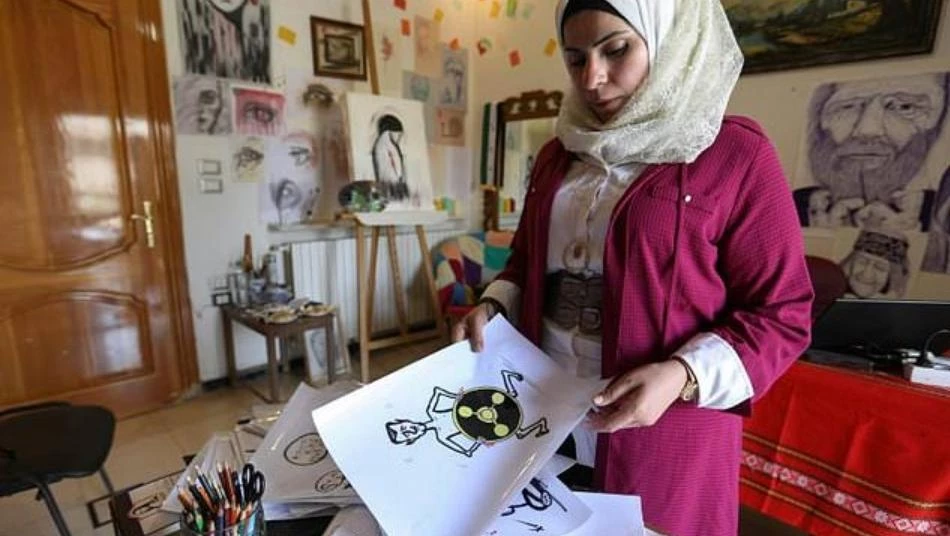"I'm trying to get across what others struggle to say," said the 30-year-old artist, dressed in a long red jacket and lacey white headscarf.
Idlib, an opposition-run region of three million people, has come under increasing bombardment by the regime and its Russian ally since late April despite a months-old truce deal.
Through her cartoons, Ali has boldly challenged traditions to comment on life in the anti-regime bastion, and to condemn seeming international indifference to civilian deaths.
In one, the world is depicted as an ostrich burying its head in a mound of blood-drenched skulls as red missiles rain down all around.
In another, titled "Eid in Idlib", a warplane drops candy wrappers containing TNT, instead of the sweets usually distributed during the Muslim holiday.
The sketches are etched out in black and white, with splashes of red, colours the artist says are inspired by life in the opposition stronghold.
"We see nothing but blood, darkness and destruction," she said.
Ali has sketched this accord too, as a blood-stained paper bearing the words "the Idlib agreement".
On Thursday, the Assad regime said it had agreed to a new truce, giving at least a temporary reprieve for Idlib's residents.
- 'Broke with customs' -
Though her cartoons have now been exhibited as far away as the Netherlands and United Kingdom, Ali had to study drawing on the sly growing up, because her father forbade it.
"I consider myself to be a girl who broke with customs and tradition," Ali said.
"I confronted my parents and managed to impose the life I wanted for myself."
Her society, she said, frowned upon women who engaged in political satire through cartoons or art.
Before war erupted in 2011, Ali worked as an art teacher at a private school in Idlib so she could "be close to the field that I love".
But after the region fell to opposition forces, she "started a new life" as a cartoonist, often dabbling in satire to capture the reality of a war that has cost more than 370,000 lives and displaced millions across Syria.
"I hope to convey even the smallest part of civilian suffering," she said.
In November, fellow cartoonist, radio presenter and vocal activist Raed Fares was shot dead by unknown gunmen.
- Fans and enemies -
Ali said she does not criticise HTS itself, but rather its behaviour, especially when it mirrors that of the regime.

"For eight years, we have been fighting to get rid of the habits and remnants of the regime," she said.
But even now Idlib is outside regime control, "some mistakes are still happening because of a lasting regime culture," she said.
In one cartoon from last year, a bearded man in a short robe typical of ultra-conservatives inserts a giant syringe into another's ear to stuff his head with notions of what is "illicit", or religiously forbidden.
In another, she criticises overpriced higher education.
Ali's work, she said, has earned her both fans and enemies.
"Many people tell me I should be careful, that I don't know what I'm doing," she said.
"The thing I hear most is that I'm a girl and I shouldn't be drawing such things."

But abroad, people are impressed.
"During my exhibition in the UK, lots of British academics were surprised there was a girl doing drawings like this under HTS," she said.
A new exhibition has opened in France and she may soon showcase her work in neighbouring Turkey.
Though she is unlikely to attend either without the necessary visa to travel, she hopes both will help to bust stereotypes about women in northwest Syria.
Women in Idlib are not "voiceless people who are unable to leave their houses and always clad in black", she said.
"Yes, there are certain limits, but we're resisting."
Based on AFP



التعليقات (0)